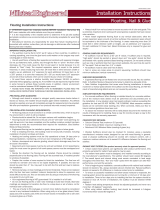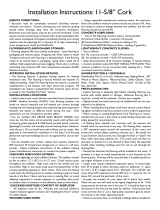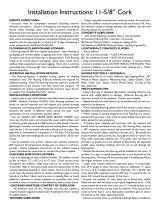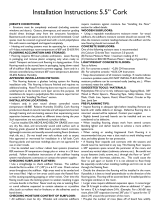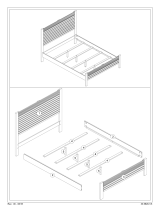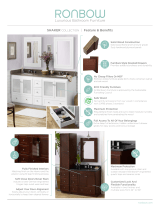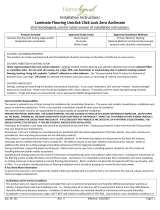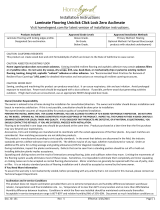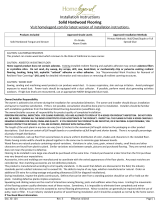Page is loading ...

GENERAL INFORMATION
ATTENTION INSTALLERS
WARNING: Installation of wood product may create wood dust, which is
known to the state of California to cause cancer. Avoid inhaling wood dust or
use a dust mask or other safeguards for personal protection.
Sawing, sanding and machining wood products can produce
wood dust. Airborne wood dust can cause respiratory, eye and
skin irritation. The International Agency for Research on Cancer
(IARC) has classied wood dust as a nasal carcinogen in humans.
Precautionary Measures: If power tools are used, they should be equipped
with a dust collector. If high dust levels are encountered, use an appropriate
NIOSH-designated dust mask. Avoid dust contact with eye and skin.
First Aid Measures in Case of Irritation: In case of irritation, ush eyes
or skin with water for at least 15 minutes.
All Engineered wood products meet and exceed CARB Phase2
compliance requirements. Certied by the HPVA (TPC-8)
Always wear appropriate personal protective equipment (PPE) which include
NIOSH or OSHA approved dust masks, safety goggles and work gloves.
WARNING: EXISTING IN-PLACE RESILIENT FLOOR COVERING AND
ASPHALTIC ADHESIVES. DO NOT SAND, DRY SWEEP, DRY SCRAPE, DRILL,
SAW, BEADBLAST, OR MECHANICALLY CHIP OR PULVERIZE EXISTING
RESILIENT FLOORING, BACKING, LINING FELT, ASPHALTIC “CUTBACK”
ADHESIVE, OR OTHER ADHESIVE.
These existing in-place products may contain asbestos fibers and/or crystalline silica.
Avoid creating dust. Inhalation of such dust is a cancer and respiratory tract hazard.
ENGINEERED WOOD INSTALLATION
3/8” OR 1/2” TONGUE & GROOVE: FLOAT, NAIL/STAPLE & FULL SPREAD GLUEDOWN
READ THESE INSTRUCTIONS COMPLETELY BEFORE BEGINNING INSTALLATION.
Smoking by individuals exposed to asbestos fibers greatly increases the risk of serious
bodily harm. Unless positively certain that the existing in-place product is a non-
asbestos-containing material, you must presume it contains asbestos. Regulations
may require that the material be tested to determine asbestos content and may
govern removal and disposal of material. See current edition of the Resilient Floor
Covering Institute (RFCI) publication Recommended Work Practices for Removal
of Resilient Floor Coverings for instructions on removing all resilient oor covering
structures.
If you have technical or installation questions please call 1-800-258-5758
IMPORTANT HEALTH NOTICE FOR RESIDENTS OF MINNESOTA ONLY:
THESE BUILDING MATERIALS EMIT FORMALDEHYDE. EYE, NOSE, AND
THROAT IRRITATION, HEADACHE, NAUSEA AND A VARIETY OF ASTHMA-
LIKE SYMPTOMS, INCLUDING SHORTNESS OF BREATH, HAVE BEEN
REPORTED AS A RESULT OF FORMALDEHYDE EXPOSURE. ELDERLY
PERSONS AND YOUNG CHILDREN, AS WELL AS ANYONE WITH A HISTORY
OF ASTHMA, ALLERGIES, OR LUNG PROBLEMS, MAY BE AT GREATER RISK.
RESEARCH IS CONTINUING ON THE POSSIBLE LONG-TERM EFFECTS OF
EXPOSURE TO FORMALDEHYDE.
REDUCED VENTILATION MAY ALLOW FORMALDEHYDE AND OTHER
CONTAMINANTS TO ACCUMULATE IN THE INDOOR AIR. HIGH INDOOR
TEMPERATURES AND HUMIDITY RAISE FORMALDEHYDE LEVELS. WHEN
A HOME IS TO BE LOCATED IN AREAS SUBJECT TO EXTREME SUMMER
TEMPERATURES, AN AIR-CONDITIONING SYSTEM CAN BE USED
TO CONTROL INDOOR TEMPERATURE LEVELS. OTHER MEANS OF
CONTROLLED MECHANICAL VENTILATION CAN BE USED TO REDUCE
LEVELS OF FORMALDEHYDE AND OTHER INDOOR AIR CONTAMINANTS.
IF YOU HAVE ANY QUESTIONS REGARDING THE HEALTH EFFECTS
OF FORMALDEHYDE, CONSULT YOUR DOCTOR OR LOCAL HEALTH
DEPARTMENT.
JOBSITE CONDITIONS
• Structure must be completely enclosed (including exterior windows and doors).
• Gutters, downspouts, and exterior grading should direct drainage away from the
structure’s foundation.
• Basements and crawl spaces must be dry and well ventilated. Crawl spaces
must be covered at ground level with a 6 mil polyethylene (poly) film with seams
overlapped and taped completely.
• Before installation begins, heating and cooling systems must be in operation for
a minimum of 14 days, maintaining a room temperature of 60-80°F degrees, and 35-
55% Relative Humidity. A humidifier or a dehumidifier may be required in some areas
to maintain these levels. Gapping and cupping are only a few of the conditions that
can develop these conditions are not maintained.
FLOORING ACCLIMATION & STORAGE
• Our Tongue & Groove Engineered wood ooring does not require jobsite
acclimation.
• If the ooring needs to be stored on the jobsite:
- Leave in package, store laying at, packages raised off of suboor (adequately
supported to prevent sagging).
- Store in a climate controlled area, 60-80°F degrees room temperature, between
35-55% RH.
INSTALLATION METHODS
• Engineered wood ooring features a tongue & groove system designed for
multiple installation methods; Float, Nail/Staple & full spread gluedown.
RADIANT HEATING SYSTEMS
• Only Oak, American Cherry and Walnut species are approved for use over in-
oor radiant heat systems.
• The radiant heat system must be designed and installed correctly according to the
manufacturer’s specifications.
• The suboor should never exceed 80°F. The overall layout and internal tubing
must remain consistent in heat range throughout the entire oor. “Hot” and “Cold”
spots within the system can alter oor performance, and void the warranty.
• Prior to beginning any installation, concrete suboors with radiant heat installed
should not exceed 2 lbs. using a standard calcium chloride test.
• Plywood suboors should not exceed a 3% difference in moisture content prior
to installation.
• To ensure a successful installation and allow excess moisture to evaporate, the
heating system should be operational and running for a minimum of 14 days prior
to installation, three to four days prior to installing the oor the system should be
reduced or shut off. At time of installation, the suboor must be between 64-68ºF.
• Radiant heat setting temperature should be adjusted gradually and never vary
more than 15º F seasonally.
• When using radiant suboor heating, heat should be increased in 5º increments.
Never exceed 80ºF.
INSTALLATION LOCATIONS
• Can be installed ON, ABOVE, and BELOW GRADE
• Can be installed on most any dry, at, clean, and structurally
sound solid surface including ooring grade plywood &
OSB board, concrete, and soundly secured existing oors
(linoleum, vinyl, tile, etc.). When doing oating installation
only, also over particle board and lightweight concrete.
• Not warranted for installing in full bathrooms.
PRE-PLANNING
• Slightly bowed (curved) boards can be installed and are
not considered to be defective.
• When cutting or sanding wood ooring it is recommended that you wear
a protective dust mask to avoid inhaling wood dust, and safety glasses for eye
protection.
• A oating oor expands and contracts with the seasons and should never be
restricted in any way. Be careful not to put fasteners (nails, screws, etc.) through the
oor or “pinch” the oor under doorways, cabinets, etc. This could cause the oor
to pull apart or buckle because it is not allowed to oat freely. Be especially careful
when installing moldings and trim not to nail into the oating oor.
• While installing ooring, it is best to work from several cartons of material to
properly blend the naturally occurring lighter and darker boards to achieve a more
uniform oor appearance. In addition, this will help distribute the random length
planks.
• Decide the direction the ooring will be installed in the room. If possible, it is
best to install perpendicular to the direction of the ooring joists. Flooring will be
accented best if installed parallel to the largest windows in the room.
• This oating wood oor requires a minimum 3/8” expansion space around the
PRE-INSTALLATION PLANNING
ABOVE GRADE
ON GRADE
BELOW GR ADE
GRADE LEVEL
SUITABLE
APPLICATIONS:
O2015-9792

perimeter of the room to allow for normal expansion and contraction, as well as
around any other vertical objects in the room (cabinets, columns, etc.). In areas larger
than 24 ft. length in either direction, an expansion break in the ooring (covered
by T-Molding), or additional expansion space is required. Allow an additional 1/4”
space for every 12 ft. in length above 24 ft. Example: For a 36’x36’ size room, allow
5/8” expansion (normal 3/8” plus 1/4” expansion for the 12ft. over 24ft.) in both
directions.
• Pre-plan the number of rows (based off of board face width). Often the last row
will need to be ripped lengthwise to fit. If the measurement for the last row is less
than 2” (allowing for required expansion space), it would best to rip the boards in
the first and last rows to balance the installation. If the ripped boards have to be
narrower than 2”, use a high quality carpenter’s glue to secure the narrower boards
to the wider adjoining planks.
• Remove any base, shoe, or threshold moldings prior to beginning installation.
PRE-INSTALLATION PLANNING CONTINUED
These can be replaced at the end of the install.
• Under cut door jambs to allow for expansion space and to avoid difficult scribe
cuts. This can be done by using a small piece of the ooring as a guide/rest for your
jamb saw. Expansion breaks (covered by T-Molding) are recommended in doorway
ooring.
• The use of putty to fill small gaps or correct minor
defects should be considered normal in any wood
ooring installation. When using putty on low sheen
(gloss) wood oors, use a plastic putty knife and remove
excess immediately with a soft cloth to prevent gloss-up
of the finish.
CHECKING SUBFLOOR FLATNESS
• Use a straight edge to determine suboor atness (throughout oor). The
suboor should be at to within 3/16” in an 8’ area.
• High areas need to be sanded and low areas filled. NEVER SAND ANY EXISTING
FLOOR OR ADHESIVE SUSPECTED TO CONTAIN ASBESTOS OR CRYSTALLINE
SILICA (such as resilient vinyl or linoleum, or the adhesives used to bond them).
• High or low areas in the suboor could cause the oated oor to ex causing
squeaking, popping, or other noises. Over time this exing could also cause the
locking system to weaken resulting in gaps or loose boards in the oor.
CHECKING SUBFLOOR MOISTURE
WOOD SUBFLOORS:
• The moisture content of the suboor must be checked using a reputable
manufacturer’s moisture meter. Wood suboors should not exceed a 14% moisture
content, and the moisture variance between the wooden suboor and the new
ooring to be installed should not exceed 4%.
CONCRETE SUBFLOORS:
• When ooring is installed directly to a concrete suboor, one of the following
moisture tests is recommended:
• Calcium Chloride Test (maximum 3.0 pounds)
• Tramex Moisture Meter (maximum reading of 4.5)
• Delmhorst BD2100 Moisture Meter (reading of green/dry)
• RH (Relative Humidity) should not exceed 75% in slab
• Keep documentation of all moisture readings. If results indicate a moisture
problem exists, DO NOT INSTALL THE FLOORING! Most moisture issues can
be corrected easily (sealing, etc.). When corrected, retest the suboor to assure
moisture guidelines have been met.
SUBFLOOR REQUIREMENTS
TOOLS NEEDED
• Roll out foam underlayment (follow instructions inside packaging). On a concrete
suboor, if you are using an underlayment that does not have a vapor barrier
attached, loose lay 6 mil poly sheeting with the seams overlapped 8”, taped with
clear packaging tape and lapped up the wall but not touching the sheetrock. Then
roll out underlayment, butting edges. For installations over a plywood suboor it is
not necessary to use poly sheeting, and foam underlayment may or may not have a
vapor barrier attached.
• Never open the bundles until ready to start the installation process.
• When the decision is made on the direction the boards will run, start at one side
wall with the first row of boards allowing an expansion space along side and end
walls with the use of wood wedges (equivalent spacers.) Extra expansion space is
required in large areas (i.e. one room; two rooms with adjoining archways or a room
with an extended hallway) measuring more than 24 linear feet in either direction
(width or length). Either install a T-molding across the width of the room, archway
or use an additional 1/4” expansion for each additional 12 linear feet (i.e. for a 3/8”
product in a room that measures 36’ x 36’ you would leave 5/8” expansion around
all vertical surfaces which can be covered by your choice of molding).
SIDE AND END GLUING
• The engineered boards must be side and end glued using wood glue. Apply glue
in the groove of each plank as you install . Begin at the end and fill the entire length
of the board. Fully glue the end joint. It is very important to fill the groove to its
full thickness. This will ensure proper transfer to the tongue of the adjoining planks.
Failure to follow proper glue schedule will void all warranties. If any excess glue
squeezes up to the finished surface, wipe off using a paper towel or cloth.
INSTALLING THE LAST ROW
• The boards in the last row will need to be cut to the necessary width. Remember
to allow the appropriate expansion space between the last row and any vertical
surface it adjoins. Mark the board to the correct width and contours of the wall.
• After the oor is completely installed, remove spacers, install molding and
thoroughly clean the oor with an approved Wood Floor Cleaner.
• Never cover a newly installed oor with plastic. Always use a breathable material
such as craft paper or cardboard.
INSTALLING FLOOR
FLOATING INSTALLATION
• Foam Underlayment
• 6-mil Polyethylene film (if going over concrete)
• Roberts #1406 T&G Adhesive
• Chalk Line
• 3/8” Wood or Plastic Spacers
• T-square
• Tapping Block
• Pencil
• Measuring Tape
• Wood Chisel
• Safety Glasses
• Circular or Rip Saw
• Jamb Saw
• Dust Mask
• Knee Pads
• Pull Bar
TOOLS NEEDED
NAIL/STAPLE INSTALLATION
• 15 lb. Asphalt felt or Roberts Silicone Vapor Shield (SVS)
• Chalk Line
• 3/8” Wood or Plastic Spacers
• Square
• Tapping Block
• Pencil
• Tape measure
• Wood Chisel
• Safety glasses
• Circular or rip saw
• Jamb Saw
• Dust mask
• Knee pads
• Pull bar
FOR 3/8”: PNEUMATIC OR MANUAL NAILER/STAPLER FOR USE WITH
3/8” FLOORS
• 80-85 lb of air pressure
• 1” minimum fastener length
• 20 Gauge
FOR 1/2”: PNEUMATIC OR MANUAL NAILER/STAPLER FOR USE WITH
1/2” FLOORS
• 80-85 lb of air pressure
• 1-1/4” minimum fastener length
• 18 Gauge

PLEASE SEE PAGE 1 FOR PRE-INSTALLATION REQUIREMENTS
GENERAL SUBFLOOR REQUIREMENTS
• All suboors must be at to 3/16” per 8’ radius. If suboor prep is required, “high
spots” should be sanded or ground down. Do not sand surfaces such as vinyl or
synthetic tiles that may contain asbestos.
• All suboors must be clean and free of debris.
• Nail or screw any loose areas to prevent squeaking. Suboors should have
minimum deection (vertical movement).
SUBFLOOR REQUIREMENTS
• These products can be installed over dry, at wood suboors such as plywood
and OSB. If used over an existing suboor, the thickness of the overlay material must
be such as to yield a total of ¾” suboor thickness.
• Particle board is NOT recommended for staple down installations.
• NOTE: SUBFLOOR IRREGULARITIES THAT CAUSE WOOD FLOORING
INSTALLATIONS TO DEVELOP MOVEMENT OR HOLLOW SPOTS BETWEEN
THE SUBFLOOR AND THE WOOD FLOORING, ARE NOT THE RESULT OF
MANUFACTURING DEFECTS AND ARE NOT COVERED BY WARRANTIES.
SUBFLOOR MOISTURE REQUIREMENTS
• Wooden Suboors should be checked for moisture using a reputable
manufacturer’s moisture meter, designed for use with wood ooring. In general,
wood or plywood subooring should not exceed 14% moisture content, with a
maximum moisture variance not to exceed 4% difference between the ooring and
suboor.
INSTALLING FLOOR
INSTALLING THE FLOOR
• The clean suboor surface should be covered, wall-to-wall, with 15-lb. asphalt
saturated felt or SVS. Lap the edges of the felt/SVS 4” when positioning. Double the
felt/SVS around heating ducts.
• Flooring should be laid at right angles to the oor joists and, if possible, in the
direction of the longest dimension of the room.
• Snap a working line parallel to the starting wall, allowing for expansion space.
(Expansion space should be equivalent to the thickness of the ooring.)
• With the tongue out, lay one row of planks along the length of the working line.
The first row should be face-nailed and countersunk.
• Subsequent rows should be blind nailed wherever possible. With the proper nailer,
nail planks every 4”- 6” and within 2” of the end joint. Push or gently tap boards ush
to the previous row. Only tap against the tongue; tapping the groove may damage
edges.
• Stagger at least 6” between end joints of adjacent board rows. End joints should
not repeat visually across the installed oor. Avoid “H” joints and other discernible
patterns.
• Face-nail and countersink final rows of ooring as necessary.
IMPORTANT NOTES:
• The use of putty to fill small gaps or correct minor defects should be considered
normal in any hardwood installation.
• Hardwood oors should be maintained year round at 35-55% relative humidity
and a temperature between 60-80 degrees. A humidifier / de-humidifier may be
necessary in some homes to maintain these climate conditions.
TOOLS NEEDED
GLUEDOWN INSTALLATION
• Urethane adhesive
• Adhesive remover
• Trowel (check adhesive for recommended notch/size)
• Hammer
• Tape Measure
• Safety Glasses
• Chalk line
• Square
• Pencil
• Wood Chisel
• Circular or rip saw
• Jamb Saw
PLEASE SEE PAGE 1 FOR PRE-INSTALLATION REQUIREMENTS
INSTALLING THE FLOOR
• When the decision is made on the direction the boards will run, snap a working
line parallel to the starting wall, allowing the width of a board plus the tongue and
expansion space. (Expansion space should be equivalent to the thickness of the
ooring.) Temporarily nail a straight starter board along the edge of the working line.
• Once the starter board is secured, apply adhesive to the substrate with the proper
trowel. (Flooring may be installed using either a “wet-lay” or “walk-on” method.
• For “wet-lay” installations, ooring is placed into “wet” adhesive; workers do not
walk on ooring during installation. For “walk-on” installations, spread the adhesive
and allow the adhesive to develop “tack”, then begin to install the ooring material.)
Spread adhesive up to and along the working line.
• Install the first row of planks along the working line with the tongue-side facing
the starting wall. Continue installing subsequent rows, inserting the tongue into the
groove of the previous row. Boards should be engaged by hand. Stagger at least 6
inches between end joints of adjacent board rows. End joints should not repeat
INSTALLING FLOOR
visually across the installed oor. Insure that the proper expansion space is left at
the perimeter of the room.
• As you work, immediately clean any adhesive from the surface of the ooring
using mineral spirits and a soft cloth, being careful not to damage the finish. Lift a
plank periodically to check adhesive transfer. >80% coverage is required.
• After the large part of the room is installed, remove the starter board and
complete the installation. Install moldings and thoroughly clean the oor with an
approved Wood Floor Cleaner. Never cover a newly installed oor with plastic.
Always use a breathable material such as craft paper or cardboard.
IMPORTANT NOTES
• The use of putty to fill small gaps or correct minor defects should be considered
normal in any hardwood installation.
• Hardwood oors should be maintained year round at 35-55% relative humidity
and a temperature between 60-80 degrees. A humidifier / de-humidifier may be
necessary in some homes to maintain these climate conditions.
INSTALLATION TIP 1
• To assist with the stability of the first few rows, we recommend that you install
the first row, then 2 to 3 boards in the second row, then 1 to 2 boards in the third
row. Go back to the second row and install another 2 boards, then 2 boards in the
third row. Complete this “stepping” arrangement until the three rows are complete.
Always stagger the end joints of adjacent rows a minimum of 12”. Try to avoid a
“stair-step” pattern when looking across several rows, and try to avoid “H” patterns
in the installation.
1
9
8
7
6
54
32
10
Maintain a 12”
Stagger
INSTALLATION TIP 2
• In narrow areas (i.e. hallways) where planks will be installed width wise, the planks
must be staggered to incorporate at least one end joint in every other row. Installing same
length boards side by side without this stagger will cause the ooring to bow upward.
INSTALLATION TIPS:
INCORRECT CORRECT
INSTALLATION TIP 3
• Transition pieces (moldings), and the oor itself, are made from real wood and
will exhibit all the natural variations of the particular species. Every transition piece
will not match every board of ooring. Therefore, the best results will be achieved
by identifying boards that are complimentary to the transition prior to installation,
setting the boards aside to be installed next to the transition.

FLOOR CARE AND PREVENTIVE MAINTENANCE
With today’s finishes, maintenance of your wood oor could not be easier. Normal
maintenance consists of regular sweeping or vacuuming to collect dirt and grit that
can dull your finish, along with periodic use of an approved no-wax hardwood oor
cleaner. For Handscraped/Distressed oors, the uneven surface may trap dirt and
dust so we recommend vacuuming more often. Always vacuum thoroughly prior to
the use of approved oor cleaner. Be certain the wheels of the vacuum are clean and
do not damage the finish. Scrubbing machinery, power scrubbers and steam cleaners
are not recommended to clean the oor.
PREVENTIVE MAINTENANCE
Aside from those mentioned above, other steps can also be taken to minimize wear
and tear and keep your oor looking new for years to come.
• DO NOT USE liquid or paste wax, oil soaps, or any other cleaners that contain
silicon, lemon oil, tung oil, acrylics or ammonia. Furthermore, avoid ‘home recipes’
found on the internet or other sources. These products and techniques can cause
your oors to become slippery, or cloud and dull the finish. Use of these and similar
products can harm the performance of your oor and may also affect its re-coat
ability.
• DO NOT USE A VACUUM WITH A BEATER BAR HEAD
• Use throw rugs inside and outside of entryways to prevent dirt and grit from
being tracked in and scratching your finish. Rugs, mats or backings should not be
abrasive to prevent scratching to the wood oor. Material should be breathable to
avoid trapping moisture underneath.
• Wood and water don’t mix! Never damp mop your oor. Clean up spills promptly
with a soft cloth and recommended cleaning products.
• Place felt-type protectors on the bottom of all furniture and fixture legs to assist
in preventing denting and scratching.
• High heels and sports cleats will likely dent, gouge or scratch hardwood oors,
which is not covered by our warranty.
• Keep pet’s nails trimmed and clean of dirt and debris.
• Avoid sliding or rolling heavy furniture or appliances across the oor. Whenever
possible, lift the item to be moved. If it must be rolled, protect the oor with plywood
or other hard sheeting to prevent dents.
• Use a humidifier/dehumidifier to maintain a consistent year round climate,
keeping wood shrinkage and movement to a minimum.
• The exposure of sun, UV rays and artificial lighting accelerate the oxidation and
aging of wood. This can cause the wood and/or stain to change color and/or fade
over time. If possible, we recommend that you rearrange fixtures, rugs and furniture
periodically to ensure the ooring ages evenly. Our warranties do not cover damage
from the sun, UV rays or artificial light. Note: American Cherry and Walnut species
are especially susceptible to the effect of light and may darken or lighten due to
UV or artificial light exposure. These species change color more rapidly than other
Domestic Species.
• Furniture casters should have wheels constructed with soft, non-marring/marking
material such as soft rubber, or covered with felt. Hard wheeled casters such as
plastic, vinyl or hard rubber can mark or dent hardwood oors. Caster wheel width
and diameter should comply with load guidelines.
/


